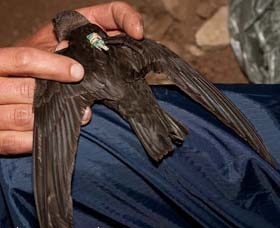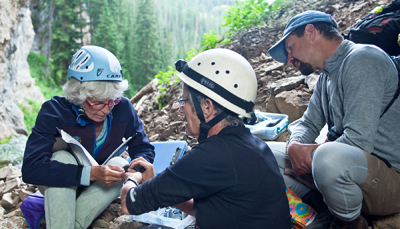The last bird that breeds in the U.S. and Canada with an unknown winter destination has finally given up its secret. After years of research – and with some luck – three Colorado researchers have learned that Black Swifts travel more than 4,000 miles to spend the winter in Brazil. The destination came as a surprise to the researchers since Black Swifts have not been documented in Brazil.
On their frequent outings to observe swifts at waterfalls and caves in the southern Rockies, long-time Black Swift researchers Carolyn Gunn, Kim Potter of the U.S. Forest Service, and Jason Beason, Rocky Mountain Bird Observatory’s special monitoring projects coordinator, often discussed how they could discover this missing piece of the bird’s basic life-cycle information.

Black Swift with geolocator by Todd Patrick
Then rapid advancements in technology produced light-level geolocators, tiny devices weighing 1.2 grams that enable researchers to track small birds. The team raised funds to purchase four geolocators in 2009 and attached them to four Black Swifts they captured in western Colorado.
Luckily the researchers recaptured three of the four birds a year later. They removed the geolocators and analyzed the data. All three yielded similar information about the birds’ flight paths and their winter destination: the center of all the location fixes fell in northwest Brazil.

Black Swift researchers by Todd Patrick
The 2010 State of the Birds Report listed the Black Swift as one of the species most vulnerable to the anticipated effects of climate change, making this research especially important to those involved with conservation and land management in the swift’s breeding range. The research was published in the March 2012 issue of The Wilson Journal of Ornithology.
Also see:
- Story in the Denver Post
- “The Coolest Bird: A Natural History of the Black Swift and Those Who Have Pursued It” by Rich Levad, available at the American Birding Association web site: www.aba.org/thecoolestbird.pdf


